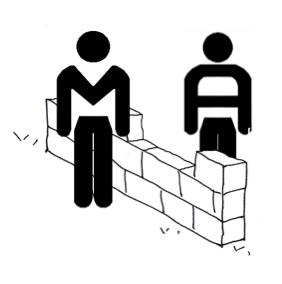Engage step of the Encounter Process

In this step I come into contact with my client, either physically or remotely. Even if I know them well, the first part of the Engage step is important for establishing good communication, allowing each party to understand the level of motivation of the other, their state of readiness and their ability to contribute to the proceedings. For example, if the person I am meeting seems less energetic and motivated than usual, an effective Engage step will allow me to notice that something is amiss (even if I cannot necessarily understand why).
Note that the obstacle of the initial wall of resistance exists even when people are (intellectually speaking) keen to meet. It is the natural result of the coming together of objects travelling with different speeds and directions. Prior to the encounter, each person is doing their own thing, and so they have to perform a kind of docking manoeuvre, matching their trajectories.
It is therefore important that the initial impression I make through my dress and demeanour (posture, voice, facial expression, etc.) is a positive one. I can control my dress easily, but demeanour is more tricky. I need to make sure that I am in good shape – prepared, alert and reasonably relaxed- before the meeting starts. The overall impression that I make depends a great deal on what my client picks up subconsciously.
These considerations are just as important when I know my client well as they are for first meetings. In fact, I should be particularly vigilant if my client is well known to me, and not take their willingness to receive me for granted. Perhaps they have particular worries today – pressures from work or elsewhere?
Easy stuff must not be neglected; for example:
- I arrive ‘on time’, interpreting the latter expression according to the local culture (if in doubt, it is best to really be on time!)
- I take a minute or two to think about the people that I am meeting, to get focused on them.
- If I will be meeting people for the first time, I prepare for the mental effort of remembering new names and I make sure that I have visiting cards ready.
If the situation allows, and I have sufficient control over the proceedings, I should ensure that everyone in the meeting is properly included. Inclusion is a term that comes from the psychology of the workplace and, in order to ensure a good level of inclusion, it is necessary to take some explicit action. Pre-meeting chat is not sufficient.
How I achieve inclusion will depend on the nature of the meeting: on whether it is a regular meeting or a one-off, on the duration, on the mix of people, on the medium (face-to-face or telephone?), etc. The key thing is that everybody must say something, however brief. Hence, for a regular weekly meeting, one technique is to have each participant mention one thing, serious/funny/personal/professional, that has happened in their lives in the past week. For a three-day technical review meeting with a customer, a more serious introduction would be appropriate.
A short inclusion process can ensure that everyone present is integrated into the proceedings. That is, they are acknowledged by the other people present and they put their other concerns aside in order to be able to concentrate on the meeting itself. Whatever method is chosen, taking a few minutes out at the start of the Engage step to achieve this is an excellent practice.
The second half of the Engage step can then transition from the alignment of people to the alignment of expectations and plans. What’s at stake here is both the efficiency and effectiveness of the encounter. The PAGE tool can be used to facilitate this transition.
More about The Encounter Process:
- The Encounter Process top
- The Encounter is a Theory We Use
- Challenge example: it isn’t just about relationships – process matters too
- Challenge example: jumping ahead too quickly
- The Obstacle Course
- The Encounter Process explained
- Prepare step of the Encounter Process
- Engage step of the Encounter Process
- Do step of the Encounter Process
- Check step of the Encounter Process
- Follow Up step of the Encounter Process
- The Encounter Process in brief
Get the Client Encounters of the Technical Kind book!
